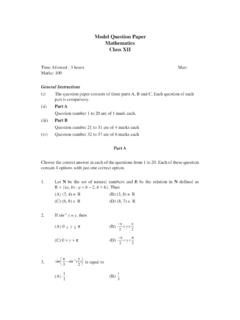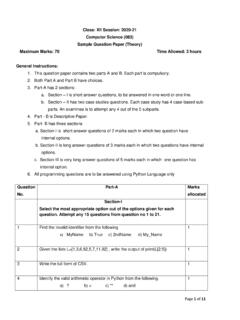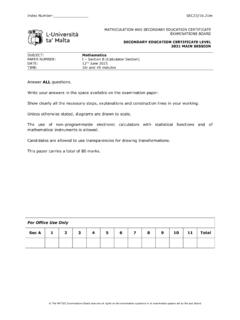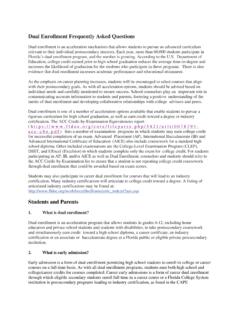Transcription of Pearson Edexcel Cenre uer Cnte uer Level 3 GCE Wednesday 7 ...
1 Please check the examination details below before entering your candidate information Candidate surname Other names Centre Number Candidate Number Pearson Edexcel Level 3 GCE. Wednesday 7 October 2020. Morning ( time : 2 hours) Paper Reference 9MA0/01. Mathematics Advanced Paper 1: Pure Mathematics 1. You must have: Total Marks Mathematical Formulae and Statistical Tables (Green), calculator Candidates may use any calculator allowed by Pearson regulations. Calculators must not have the facility for symbolic algebra manipulation, differentiation and integration, or have retrievable mathematical formulae stored in them. Instructions Use black ink or ball-point pen. If pencil is used for diagrams/sketches/graphs it must be dark (HB or B). Fill in the boxes at the top of this page with your name, centre number and candidate number.
2 Answer all questions and ensure that your answers to parts of questions are clearly labelled. Answer the questions in the spaces provided there may be more space than you need. You should show sufficient working to make your methods clear. Answers without working may not gain full credit. Inexact answers should be given to three significant figures unless otherwise stated. Information AThere booklet Mathematical Formulae and Statistical Tables' is provided. are 16 questions in this question paper. The total mark for this paper is 100. use this asfora guide The marks each question are shown in brackets as to how much time to spend on each question. Advice Read each question carefully before you start to answer it. Try to answer every question. Check your answers if you have time at the end.
3 Turn over *P66785A0152*. P66785A. 2020 Pearson Education Ltd. 1/1/1/1/1/. 1. (a) Find the first four terms, in ascending powers of x, of the binomial expansion of 1. (1 + 8 x ) 2. giving each term in simplest form. (3). 1. (b) Explain how you could use x = in the expansion to find an approximation for 5. 32. There is no need to carry out the calculation. (2). _____. _____. _____. _____. _____. _____. _____. _____. _____. _____. _____. _____. _____. _____. _____. _____. _____. _____. _____. _____. _____. _____. _____. _____. _____. _____. _____. _____. 2. *P66785A0252*. Question 1 continued _____. _____. _____. _____. _____. _____. _____. _____. _____. _____. _____. _____. _____. _____. _____. _____. _____. _____. _____. _____. _____. _____. _____. _____.
4 _____. _____. _____. _____. _____. _____. _____. _____. _____. _____. (Total for Question 1 is 5 marks). 3. *P66785A0352* Turn over 2. By taking logarithms of both sides, solve the equation 43 p 1 = 5210. giving the value of p to one decimal place. (3). _____. _____. _____. _____. _____. _____. _____. _____. _____. _____. _____. _____. _____. _____. _____. _____. _____. _____. _____. _____. _____. _____. _____. _____. _____. _____. _____. _____. _____. _____. _____. _____. 4. *P66785A0452*. Question 2 continued _____. _____. _____. _____. _____. _____. _____. _____. _____. _____. _____. _____. _____. _____. _____. _____. _____. _____. _____. _____. _____. _____. _____. _____. _____. _____. _____. _____. _____. _____. _____. _____. _____. _____. (Total for Question 2 is 3 marks).
5 5. *P66785A0552* Turn over 3. Relative to a fixed origin O. point A has position vector 2i + 5j 6k point B has position vector 3i 3j 4k point C has position vector 2i 16j + 4k . (a) Find AB. (2). (b) Show that quadrilateral OABC is a trapezium, giving reasons for your answer. (2). _____. _____. _____. _____. _____. _____. _____. _____. _____. _____. _____. _____. _____. _____. _____. _____. _____. _____. _____. _____. _____. _____. _____. _____. _____. _____. _____. _____. 6. *P66785A0652*. Question 3 continued _____. _____. _____. _____. _____. _____. _____. _____. _____. _____. _____. _____. _____. _____. _____. _____. _____. _____. _____. _____. _____. _____. _____. _____. _____. _____. _____. _____. _____. _____. _____. _____. _____. _____. (Total for Question 3 is 4 marks).
6 7. *P66785A0752* Turn over 4. The function f is defined by 3x 7. f (x) = x , x 2. x 2. (a) Find f 1(7). (2). ax + b (b) Show that ff (x) = where a and b are integers to be found. x 3. (3). _____. _____. _____. _____. _____. _____. _____. _____. _____. _____. _____. _____. _____. _____. _____. _____. _____. _____. _____. _____. _____. _____. _____. _____. _____. _____. _____. _____. _____. 8. *P66785A0852*. Question 4 continued _____. _____. _____. _____. _____. _____. _____. _____. _____. _____. _____. _____. _____. _____. _____. _____. _____. _____. _____. _____. _____. _____. _____. _____. _____. _____. _____. _____. _____. _____. _____. _____. _____. _____. (Total for Question 4 is 5 marks). 9. *P66785A0952* Turn over 5. A car has six forward gears. The fastest speed of the car in 1st gear is 28 km h 1.
7 In 6th gear is 115 km h 1. Given that the fastest speed of the car in successive gears is modelled by an arithmetic sequence, (a) find the fastest speed of the car in 3rd gear. (3). Given that the fastest speed of the car in successive gears is modelled by a geometric sequence, (b) find the fastest speed of the car in 5th gear. (3). _____. _____. _____. _____. _____. _____. _____. _____. _____. _____. _____. _____. _____. _____. _____. _____. _____. _____. _____. _____. _____. _____. _____. _____. _____. 10. *P66785A01052*. Question 5 continued _____. _____. _____. _____. _____. _____. _____. _____. _____. _____. _____. _____. _____. _____. _____. _____. _____. _____. _____. _____. _____. _____. _____. _____. _____. _____. _____. _____. _____. _____. _____.
8 _____. _____. _____. (Total for Question 5 is 6 marks). 11. *P66785A01152* Turn over 6. (a) Express sin x + 2 cos x in the form R sin (x + ) where R and are constants, R > 0.. and 0 < <. 2. Give the exact value of R and give the value of in radians to 3 decimal places. (3). The temperature, C , inside a room on a given day is modelled by the equation t t . = 5 + sin 3 + 2 cos 3 0 t < 24. 12 12 . where t is the number of hours after midnight. Using the equation of the model and your answer to part (a), (b) deduce the maximum temperature of the room during this day, (1). (c) find the time of day when the maximum temperature occurs, giving your answer to the nearest minute. (3). _____. _____. _____. _____. _____. _____. _____. _____. _____. _____. _____. _____.
9 _____. _____. _____. _____. _____. _____. _____. _____. _____. 12. *P66785A01252*. Question 6 continued _____. _____. _____. _____. _____. _____. _____. _____. _____. _____. _____. _____. _____. _____. _____. _____. _____. _____. _____. _____. _____. _____. _____. _____. _____. _____. _____. _____. _____. _____. _____. _____. _____. _____. _____. 13. *P66785A01352* Turn over Question 6 continued _____. _____. _____. _____. _____. _____. _____. _____. _____. _____. _____. _____. _____. _____. _____. _____. _____. _____. _____. _____. _____. _____. _____. _____. _____. _____. _____. _____. _____. _____. _____. _____. _____. _____. _____. 14. *P66785A01452*. Question 6 continued _____. _____. _____. _____. _____. _____. _____. _____. _____. _____. _____. _____.
10 _____. _____. _____. _____. _____. _____. _____. _____. _____. _____. _____. _____. _____. _____. _____. _____. _____. _____. _____. _____. _____. _____. (Total for Question 6 is 7 marks). 15. *P66785A01552* Turn over 7. y C. 25. R. ( 2, 13). l O x Figure 1. Figure 1 shows a sketch of a curve C with equation y = f (x) and a straight line l. The curve C meets l at the points ( 2, 13) and (0, 25) as shown. The shaded region R is bounded by C and l as shown in Figure 1. Given that f (x) is a quadratic function in x ( 2, 13) is the minimum turning point of y = f (x). use inequalities to define R. (5). _____. _____. _____. _____. _____. _____. _____. _____. _____. _____. _____. _____. _____. 16. *P66785A01652*. Question 7 continued _____. _____. _____. _____.




